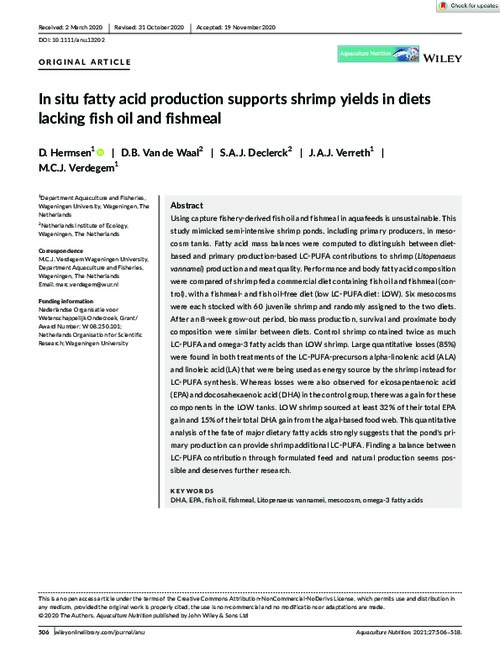In situ fatty acid production supports shrimp yields in diets lacking fish oil and fishmeal

Using capture fishery‐derived fish oil and fishmeal in aquafeeds is unsustainable. This study mimicked semi‐intensive shrimp ponds, including primary producers, in mesocosm tanks. Fatty acid mass balances were computed to distinguish between diet‐based and primary production‐based LC‐PUFA contributions to shrimp (Litopenaeus vannamei) production and meat quality. Performance and body fatty acid composition were compared of shrimp fed a commercial diet containing fish oil and fishmeal (control), with a fishmeal‐ and fish oil‐free diet (low LC‐PUFA diet: LOW). Six mesocosms were each stocked with 60 juvenile shrimp and randomly assigned to the two diets. After an 8‐week grow‐out period, biomass production, survival and proximate body composition were similar between diets. Control shrimp contained twice as much LC‐PUFA and omega‐3 fatty acids than LOW shrimp. Large quantitative losses (85%) were found in both treatments of the LC‐PUFA‐precursors alpha‐linolenic acid (ALA) and linoleic acid (LA) that were being used as energy source by the shrimp instead for LC‐PUFA synthesis. Whereas losses were also observed for eicosapentaenoic acid (EPA) and docosahexaenoic acid (DHA) in the control group, there was a gain for these components in the LOW tanks. LOW shrimp sourced at least 32% of their total EPA gain and 15% of their total DHA gain from the algal‐based food web. This quantitative analysis of the fate of major dietary fatty acids strongly suggests that the pond's primary production can provide shrimp additional LC‐PUFA. Finding a balance between LC‐PUFA contribution through formulated feed and natural production seems possible and deserves further research.
Permalink
Date Available
Type
Publisher
ISSN
1353-5773
Copyright
CC-BY-NC-4.0
Research Themes
Language